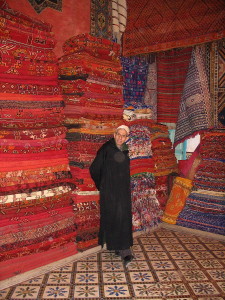HG’s beloved, late sister, Beulah Naomi Katz, loved to negotiate. The Yiddish word for negotiate is handel and Beulah was a world class handeler. She probably inherited this talent from HG’s Mom, Ida Kopkind Freeman. Beulah once took Mom to Best & Co., the venerable Fifth Avenue department store, to buy gloves. Mom asked the saleslady the price of a pair: “Nine dollars, Madam.” Said Mom: “I’ll give you five.” Beulah had to point out that while this tactic might work in The Bronx, it was ineffectual on Fifth Avenue. A jewelry vendor in a Morocco market said of Beulah, admiringly,: “She bargains like a Berber woman.” HG/BSK’s children enjoyed accompanying Beulah to American flea markets, church sales, stoop sales and yard sales. Whatever the price (a quarter), Beulah was sure to get it for less (“A quarter? This is my niece, an award winning journalist — she’ll pay a nickel”). However rarely, Beulah’s handeling skills didn’t always succeed. She was very fond of sweet Vidalia onions from Georgia. When in Atlanta for a family event, Beulah met the leading produce broker of Vidalia onions. Beulah wanted a monthly shipment and she wanted them at a wholesale price. No, said the broker, you will pay retail. A hot and heavy negotiation took place. The broker wouldn’t budge. An almost irresistible force had met an immovable object. Beulah got her Vidalias. She paid retail. HG enjoyed negotiating for rugs in the souk at Marrakech. This retail maze is one of the features of the colorful Moroccan city. The rug merchant would unroll many rugs. HG would favor one rug. The merchant would state the price. Astronomical. HG would look sad, and between sips of mint tea offered by the hospitable rug seller, would make a gracious speech: “Dear Sir, you have beautiful, rare rugs. I am honored to have seen them in your distinguished shop. Alas, though American, I have very limited means. The pressures of educating my children, etc. I have champagne tastes but a beer budget. I don’t want to insult you by offering the low sum I can afford.” The merchant was sympathetic. “You are very courteous. I will not be insulted. Name your price.” HG said the number. The merchant laughed. Was HG joking? After these preliminaries, the bargaining began. Back and forth flew the numbers. Finally, HG named his final price. An emphatic “No”. HG/BSK said goodbye and left the shop. After a few steps, HG felt a tug at his shoulder. It was the merchant. The final price was accepted. It was about 80% lower than the original sum asked by the seller. It was a very successful encounter. HG thought he had snared a bargain. The vendor, HG is sure, happily enjoyed a substantial profit. A satisfactory haggle.
The Art of Negotiation
June 9th, 2015 § 0 comments § permalink
Street Food Renaissance
March 3rd, 2013 § 0 comments § permalink
HG has always enjoyed street food starting with the sweet potatoes, chickpeas, ices and chunks of coconut that were sold along the Bronx streets in HG’s youth. During early manhood HG fancied the grilled Italian sausages with onions and peppers sold from the back of trucks in Greenwich Village. The classic New York City Sabrett hot dog, topped with onions and mustard and sold from a “hot water” cart, was always a treat. In Chinatown, anything sold on the street (no matter how unhygienic it looked) was always good. HG had excellent wurst and rye bread on the streets of Prague and even better wurst at the foot of ski slopes in the Italian mountain town of Selva Val Gardena. HG bought a very savory spleen (yes, spleen) sandwich from a Palermo vendor. HG was not a tripe fan (HG is now a Menudo — Mexican tripe stew — addict) when HG unhappily nibbled a tripe sandwich from the famous truck in the Florence wicker market. In Brazil, HG was too timid to taste the pungent stews being sold by women tending steaming caldrons outside of public markets in Rio de Janeiro and Bahia. The largest array of street food HG ever saw was in the colorful, surreal, slightly insane Djeema el Fnaa, the famous public square in the Moroccan city of Marrakesh. Established sometime around 1147, the square is a virtual maelstrom of noise, aromas and people (native Moroccans and tourists)/ There are magicians, snake charmers, water sellers, acrobats, story tellers, young men with chained Barbary apes, dancing boys and dentists (with large displays of pulled teeth as proof of their skill and prowess). When darkness falls, scores of food stalls appear and the air is filled with smoke. Hundreds sit on benches eating, grilled lamb (and its innards), chicken and every variety of seafood. Somehow HG found the square exciting but sinister (beneath the square is a police center for the vigorous interrogation of suspicious individuals). HG never patronized any of the stalls. Today, street food is having a renaissance moment in the United States. Serious and creative chefs are opening food carts and trucks alongside the ethnic specialty trucks (which had long dominated the market) in cities throughout America. Both groups of chefs are equally drawn to the food cart’s low overhead and the ripe possibility of building an audience for your cooking before dumping a fortune into a brick and mortar restaurant. And not only are the food trucks opening, urban planners and city governments are recognizing their civic importance. Cities such as Portland are actively supporting food trucks and creating a supportive business environment to help them thrive. The trend has reached New Mexico where excellent street food can be relished all over Santa Fe. This is an attractive trend bringing interesting, affordable food to folks who haven’t the time or patience for the traditional, leisurely, sit down restaurant meal. Finally, a culinary trend HG can stand by.
Pass Me My Burnoose
February 21st, 2013 § 0 comments § permalink
HG knew that good times with a Middle Eastern bent were beckoning when HG saw BSK fill a container with preserved lemons from the Whole Foods olive counter. This was confirmed when BSK began to browse through the two best books on Moroccan and Middle Eastern food: Couscous and Other Good Food From Morocco by Paula Wolfert and Arabesque — A Taste of Morocco, Turkey & Lebanon by Claudia Roden. And, so it came to pass that Middle Eastern flavors provided great joy when two friends joined HG and BSK for dinner. The meal started with Baba Ganoush (the famous pureed eggplant dip) and Moroccan carrot salad. Then came the main: A tagine of chicken with preserved lemons and olives. Sides were Israeli couscous cooked with onions, garlic, stock and spices plus a melange of vegetables (turnips, chickpeas, onions, etc.) swimming in a savory broth. Harissa (fiery pepper paste). Warmed pita. Pinot Noir. And finally Zinfandel with dark chocolate almond bark for dessert. A much more triumphant meal than any HG and BSK encountered during their visits to the Moroccan cities of Tangier, Casablanca, Rabat, Fez, Tetuoan, Meknes and Marrakesh. To be fair to those wonderful cities, insiders confided to HG that the great meals of Morocco are to be found in private homes as restaurant dining is not really part of the culture.


